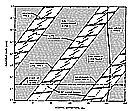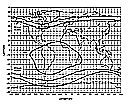IRAS Explanatory Supplement
III. The IRAS Mission
D. In-Flight Modifications
Table of Contents | Index | Previous Section | Next Section
D. 1 Introduction
Although the implementation of the survey strategy was remarkably effective, there daily arose regions of sky that should have been covered but for one reason or another (to be discussed below) were not. Attempts made to recover these scans were not always successful with a resultant loss in depth of sky coverage and data quality.
 |
|
Figure III.D.1 Lune coverage is given as a function of date. The grey
shaded regions are forbidden by the constraints indicated on the diagram.
The dashed lines running at about 45° through the clear constraint
free zones is the 90° cone angle line. The survey lune coverages
are indicated by the solid black lines. larger largest |
These coverage gaps were not predictable and so recovery scans had to be generated rapidly to allow the uplink of commands during the next prime pass some 12 hours after the downlink of the data that revealed the difficulty. Given the time needed to process the data to reveal the problem, generate the recovery observation and regenerate the SOP, this was a tight schedule to maintain. The occasional failures are reflected in some of the remaining coverage holes.
The coverage obtained in each of the first two hour confirming
layers is summarized in Fig. III.C.6.1,
2, and Fig. III.D.1.
D.2 Polar Horns

|
|
Figure III.D.2 The SAA (> 10 protons cm-2
sec-1 with E>50 MeV and Polar Horns
(>105 electrons cm-2 sec-1) with
E>0.5 MeV at an altitude of 900 km
(Stassinopoulos 1978). larger largest |
An unexpected source of noise was particle hits in the horns of the Van Allen belts (Fig. III.D.2). The effects of the horns were variable and often negligible. However, observations affected by increased noise were rescanned. The criterion used to require recovery scans for trapped particle radiation (usually in the polar horns) was that the on-board nuclear particle circumvention electronics (Section II.C.5) be activated during more than an average of about 0.7% of the time in 48 sec. This duration was determined empirically to correspond to roughly a doubling of the noise at 60 and 100 µm. In fact, because of the high of redundancy inherent in the data processing. the point source results were not noticeably affected by the level of radiation hits in the polar horns. The point source processing used both the data suffering from high radiation hit rates and the rescans. The extended emission maps (Section V.G) do not use data affected by radiation hits. In many cases the recovery scans were themselves affected by high radiation as the location of the satellite relative to the horns was often similar to that in the original scan. Losses due to the horns were greatest at the start of the mission because of a period of intense solar activity, which reduced considerably later on. The radiation recovery is discussed in greater detail by Wolff (1984).
D.3 Operations Problems
Scans lost because of occasional problems with the satellite or ground station (see e.g. Holdaway 1984, and MacDougall et al. 1984) were recovered as soon as possible after the events. Occasionally the outage was so great that it would have been impractical, within the geometrical constraints and operational timescales, to recover the gaps with individual recovery scans and it became necessary to reset the survey parameters in the scheduling program (Section III.C.7) and restart the survey from where it had left off.D.4 Saturation
Some saturation of the electronics by bright sources occurred as had been expected. Recovery on low gain was initially attempted in a systematic way and was successful for regions including the Galactic Center, the Orion Nebula M17, W43, NGC 6334, NGC 6357, and IRC+10216. It was later decided that tracking and recovering saturated portions of scans was too time consuming and that it would be more fruitful to concentrate on filling missing sky coverage due to other causes. Recovery of saturated scans was commanded only if the bright object was not one that was, from prior knowledge, expected to be very bright. Most of these sources were well known HII regions which are so bright that the saturated parts can be measured from ground or airborne telescopes.
D.5 The 5° Gap
The scan generation software required that each of the two
lunes under observation should contain an ecliptic meridian 90°
away from the Sun. Otherwise the coverage of the ecliptic
polar caps could not be part of the regular survey planning. Progress
in completing the survey was slow enough that these 90°
meridians slowly drifted toward the edge of the lunes. By mid
May 1983 only 1° of slack was left and, once the lune boundary
was reached, either a gap in the coverage would be required or
the more efficient lune method would have to be replaced with
the half circle method. A related problem was that it was becoming
necessary to make survey scans at large solar offset angles (90°
-  ). Such scans were particularly
vulnerable to interruptions
due to the SAA, station passage, Earth infrared constraint, etc.
Consequently, a large number of small holes occurred in the sky
coverage. As an important part of the sky, the North Galactic
Pole, was approaching the observation window it was decided to
avoid falling off the
). Such scans were particularly
vulnerable to interruptions
due to the SAA, station passage, Earth infrared constraint, etc.
Consequently, a large number of small holes occurred in the sky
coverage. As an important part of the sky, the North Galactic
Pole, was approaching the observation window it was decided to
avoid falling off the  = 90°
line in an uncontrolled
way determined by the accumulation of the inevitable, small losses
of coverage. A topologically simple gap was chosen that would be
accessible in the second six months of the mission (in early December).
The survey was therefore advanced by 5°, giving a 6°
pad. This decision was based on the prediction that the liquid
helium supply would last until January 1984. Unfortunately, the
last of the liquid helium boiled away in late November, leaving
the 5° gap almost completely unobserved except for a few
scans around its periphery.
= 90°
line in an uncontrolled
way determined by the accumulation of the inevitable, small losses
of coverage. A topologically simple gap was chosen that would be
accessible in the second six months of the mission (in early December).
The survey was therefore advanced by 5°, giving a 6°
pad. This decision was based on the prediction that the liquid
helium supply would last until January 1984. Unfortunately, the
last of the liquid helium boiled away in late November, leaving
the 5° gap almost completely unobserved except for a few
scans around its periphery.
D.6 Early Eclipse and Warm Up

|
|
Figure III.D.3 A diagram of the survey coverage indicates approximately
the number of hours-confirming coverages over the entire sky. larger largest |
The first eclipse of the satellite occurred 4 days earlier than expected due to an incorrect modeling of the effects of atmospheric refraction. The satellite fell into its safety mode during which no observations were made and the pattern of the third set of hours-confirming scans was interrupted. The coverage obtained before this event is shown in Fig. III.D.3. A correction to the eclipse prediction program was derived and survey operations resumed after three days. Unfortunately, on the day that the survey was resumed the liquid helium boil-off rate dropped to zero as the last of the cryogen was expended. The telescope and focal plane began to warm up. By 09h 30m on November 23, 1983, 300 days after launch, the baselines of the 12 µm detectors saturated and the flight part of the mission was officially terminated.
The final depth of coverage by hours-confirming pairs of
survey scans that was obtained is shown approximately in
Fig. III.D.3 and, in more detail in
Chapter XIII.
Table of Contents | Index | Previous Section | Next Section